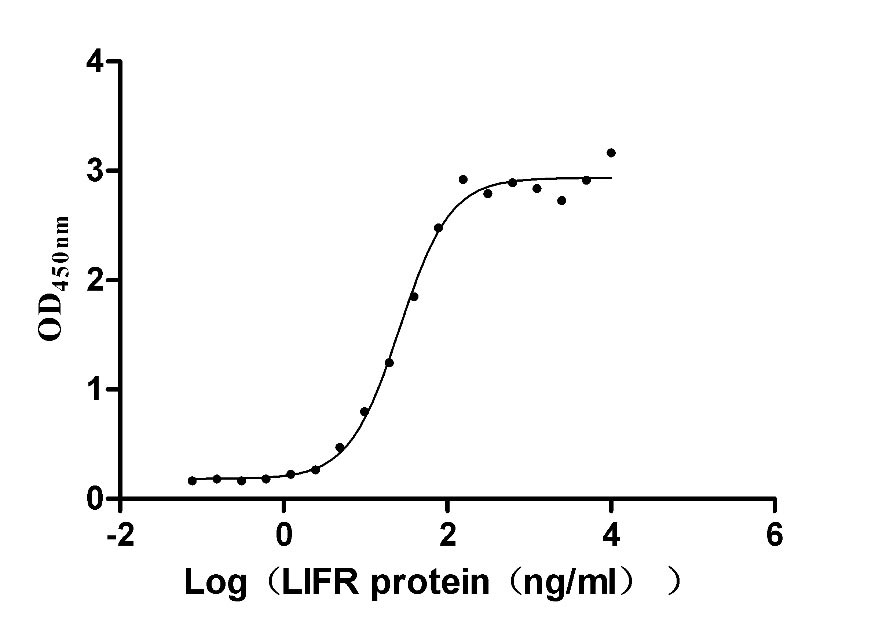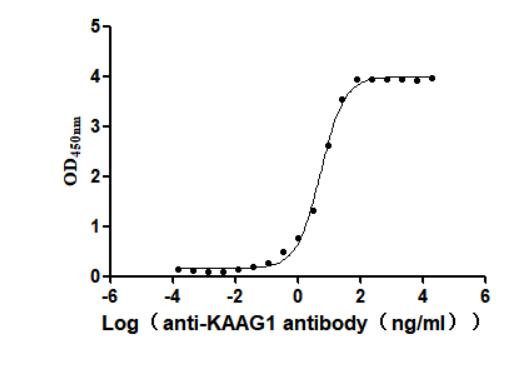Recombinant Rat Nociceptin receptor (Oprl1), partial
-
中文名称:大鼠Oprl1重组蛋白
-
货号:CSB-YP016360RA1
-
规格:
-
来源:Yeast
-
其他:
-
中文名称:大鼠Oprl1重组蛋白
-
货号:CSB-EP016360RA1
-
规格:
-
来源:E.coli
-
其他:
-
中文名称:大鼠Oprl1重组蛋白
-
货号:CSB-EP016360RA1-B
-
规格:
-
来源:E.coli
-
共轭:Avi-tag Biotinylated
E. coli biotin ligase (BirA) is highly specific in covalently attaching biotin to the 15 amino acid AviTag peptide. This recombinant protein was biotinylated in vivo by AviTag-BirA technology, which method is BriA catalyzes amide linkage between the biotin and the specific lysine of the AviTag.
-
其他:
-
中文名称:大鼠Oprl1重组蛋白
-
货号:CSB-BP016360RA1
-
规格:
-
来源:Baculovirus
-
其他:
-
中文名称:大鼠Oprl1重组蛋白
-
货号:CSB-MP016360RA1
-
规格:
-
来源:Mammalian cell
-
其他:
产品详情
-
纯度:>85% (SDS-PAGE)
-
基因名:
-
Uniprot No.:
-
别名:Oprl1; Oor; Oprl; Nociceptin receptor; Kappa-type 3 opioid receptor; KOR-3; Orphanin FQ receptor; ROR-C; XOR1
-
种属:Rattus norvegicus (Rat)
-
蛋白长度:Partial
-
蛋白标签:Tag type will be determined during the manufacturing process.
The tag type will be determined during production process. If you have specified tag type, please tell us and we will develop the specified tag preferentially. -
产品提供形式:Lyophilized powder
Note: We will preferentially ship the format that we have in stock, however, if you have any special requirement for the format, please remark your requirement when placing the order, we will prepare according to your demand. -
复溶:We recommend that this vial be briefly centrifuged prior to opening to bring the contents to the bottom. Please reconstitute protein in deionized sterile water to a concentration of 0.1-1.0 mg/mL.We recommend to add 5-50% of glycerol (final concentration) and aliquot for long-term storage at -20℃/-80℃. Our default final concentration of glycerol is 50%. Customers could use it as reference.
-
储存条件:Store at -20°C/-80°C upon receipt, aliquoting is necessary for mutiple use. Avoid repeated freeze-thaw cycles.
-
保质期:The shelf life is related to many factors, storage state, buffer ingredients, storage temperature and the stability of the protein itself.
Generally, the shelf life of liquid form is 6 months at -20°C/-80°C. The shelf life of lyophilized form is 12 months at -20°C/-80°C. -
货期:Delivery time may differ from different purchasing way or location, please kindly consult your local distributors for specific delivery time.Note: All of our proteins are default shipped with normal blue ice packs, if you request to ship with dry ice, please communicate with us in advance and extra fees will be charged.
-
注意事项:Repeated freezing and thawing is not recommended. Store working aliquots at 4°C for up to one week.
-
Datasheet :Please contact us to get it.
相关产品
靶点详情
-
功能:G-protein coupled opioid receptor that functions as receptor for the endogenous neuropeptide nociceptin. Ligand binding causes a conformation change that triggers signaling via guanine nucleotide-binding proteins (G proteins) and modulates the activity of down-stream effectors. Signaling via G proteins mediates inhibition of adenylate cyclase activity and calcium channel activity. Arrestins modulate signaling via G proteins and mediate the activation of alternative signaling pathways that lead to the activation of MAP kinases. Plays a role in modulating nociception and the perception of pain. Plays a role in the regulation of locomotor activity by the neuropeptide nociceptin.
-
基因功能参考文献:
- The present in vitro and in vivo findings show that nociceptin/orphanin FQ receptor plays a crucial conserved role regulating the levels of the glutamate/aspartate transporter GLAST/EAAT1 in both human and rodent brain astrocytes. PMID: 28906039
- Genetic deletion of NOP receptors confers resilience to drug abuse and support a role for NOP receptor antagonism as a potential treatment option for drug addiction. PMID: 27562376
- Nociceptin/orphanin FQ mRNA is increased in the striatum from stressed, social defeat animal models. PMID: 28280884
- Findings suggest that the Galphai1/Gbeta2(beta4)/Ggamma7 heterotrimeric G protein complex determines the nociceptin/orphanin FQ peptide receptor-mediated modulation of voltage-gated Ca(2+) channels channels in stellate ganglion neurons. PMID: 27238748
- The opioid-like hepta-decapeptide nociceptin/orphanin FQ and its receptor nociceptin are widely distributed in the central nervous system where they are involved in a variety of biological functions including feeding, reward and emotional processes. PMID: 26387568
- This study demonstrated the expression of the NOP receptor in human peripheral nerve and visceral tissues, with a marked increase of NOP-positive nerve fibres in urinary bladder syndromes. PMID: 27127846
- Study shows an influence of the prelimbic nociceptin/orphanin FQ neurotransmission, but not the infralimbic nociceptin receptors, in the control of cardiovascular responses observed during acute stress, by increasing cardiac parasympathetic activity. PMID: 26935148
- Nociceptin-immunoreactive cells were observed in the central and peripheral regions of the islets of both normal and diabetic rat pancreas. PMID: 25875798
- This study demonistrated that Oprl1 and Melanin-concentrating hormone colization in neuron in the lateral hypothalamus (LH) and zona incerta (ZI), but MCHR1 mRNA is widely expressed throughout the brain. PMID: 24978951
- Antagonism of endogenous N/OFQ produces anti-arrhythmic effects on ventricular arrhythmias in acute myocardial infarction, possibly via modulating PKC activity and action potential of myocytes. PMID: 23869704
- data are consistent with the interpretations that membrane estrogen receptor activation attenuates ORL1-mediated antinociception through a non-genomic, ERK 2-dependent mechanism in females PMID: 24452062
- These results confirm the existence of reciprocal interactions between serotonin and nociceptin/NOP transmissions in the dorsal raphe nucleus. PMID: 23669068
- Opioid/nociceptin receptor levels are increased in the cerebral cortex following kainic acid-induced seizures. PMID: 23337899
- the findings elaborate the effects of the N/OFQ-NOP system on cocaine-mediated extracellular dopamine; these studies confirm the widespread involvement of NOP receptors in drug addiction PMID: 23219985
- stress can affect N/OFQ expression and that glucocorticoids may constitute hormonal mediators of this complex interplay. PMID: 22074385
- ORL1 receptors are enriched in a subpopulation of sensory neurons and prolonged activation produces no functional loss of surface N-type calcium channels PMID: 22371475
- Genetic knock-out of nociceptin receptor renders rats more susceptible to the rewarding effect of morphine. PMID: 21095077
- results indicate that the peripheral nociceptin/orphanin FQ (N/OFQ)-N/OFQ peptide (NOP) system is involved in stress-induced reduction of mucosal mast cell density PMID: 21925513
- NOP receptor signalling plays an important role in controlling anxiety- and mood-related behaviours, exercise-driven locomotor activity and nociception. PMID: 21184763
- present in the uterus PMID: 20237332
- These receptors exhibit differential blocker pharmacology and allosteric regulation by sodium. PMID: 20159949
- the existence of heterodimers between ORL1 and classical opioid receptors, with profound implications for effectors such as N-type calcium channels. PMID: 19887453
- Activation of spinal ORL-1 receptors prevents acute cutaneous neurogenic inflammation: role of nociceptin-induced suppression of primary afferent depolarization. PMID: 11973003
- ORL-1 receptors in layer V of anterior cingulate cortex are located on somatodendritic elements and deafferentation increases ORL-1 receptor binding. PMID: 12842128
- Long-term effects on brain opioid receptor like-1 receptors after short periods of maternal separation in rats. PMID: 12842289
- Expression of opioid receptor-like OP-4/ORL1 is detected in the intima of ex vivo rat aortic rings, where the signal is limited to the endothelial layer, and in endothelial cells from rat brain microvessels. PMID: 14660000
- These results provide the evidence that ORL1-mu opioid receptor heterodimerization and the resulting impairment of mu receptor-activated signaling pathways may contribute to ORL1-mediated antiopioid effects in the brain. PMID: 15748148
- ORL(1) was involved in nociceptive transmission of neuropathic pain PMID: 15862535
- ORL1 receptors are located on serotoninergic neurons in the dorsal raphe nucleus PMID: 15948180
- These results suggest that two C-terminal serine residues, Ser(334) and Ser(335), are required for homologous desensitization and agonist-induced phosphorylation of opioid receptor-like 1. PMID: 16019191
- These results suggest that opioid receptor like 1 receptors have an inhibitory effect at night, and a facilitative effect in the day, on phase changes. PMID: 16310969
- NOP receptor agonists evoked a hyperphagic effect while NOP receptor antagonists blocked the hyperphagic effect. PMID: 16483692
- Changes in expression of nociceptin and its receptor in spinal dorsal horn during electroacupuncture treatment for inflammatory pain were studied. PMID: 17493706
- Altered anxiety behavior was studied in nociceptin receptor gene knockout mice. PMID: 17499882
- Results suggest that NOP receptor activation is required for cannabinoids to produce hypothermia. PMID: 17512052
- In conclusion, we present a novel mutant rat lacking NOPr without compensatory changes in mu, delta and kappa opioid receptors. We anticipate that this mutant rat will have heuristic value to further understand the function of NOPr. PMID: 19527777
- These data suggest that the endogenous nociceptin system is responsive to changes in energy balance and that nociceptin receptors specifically within the dorsal raphe may be physiologically relevant to nociceptin's effects on appetite. PMID: 19765615
显示更多
收起更多
-
亚细胞定位:Cell membrane; Multi-pass membrane protein. Cytoplasmic vesicle.
-
蛋白家族:G-protein coupled receptor 1 family
-
组织特异性:Highly expressed in several brain areas, the intestine, liver and spleen. Detected in sympathetic stellate ganglion neurons.
-
数据库链接:
KEGG: rno:29256
STRING: 10116.ENSRNOP00000047053
UniGene: Rn.9762
Most popular with customers
-
Recombinant Human Leukemia inhibitory factor (LIF) (Active)
Express system: Mammalian cell
Species: Homo sapiens (Human)
-
Recombinant Human Poliovirus receptor (PVR) (I340M), partial (Active)
Express system: Mammalian cell
Species: Homo sapiens (Human)
-
Express system: Mammalian cell
Species: Homo sapiens (Human)
-
Recombinant Human Claudin-3 (CLDN3)-VLPs (Active)
Express system: Mammalian cell
Species: Homo sapiens (Human)
-
Recombinant Macaca fascicularis Membrane spanning 4-domains A1 (MS4A1)-VLPs (Active)
Express system: Mammalian cell
Species: Macaca fascicularis (Crab-eating macaque) (Cynomolgus monkey)
-
Recombinant Human Tumor-associated calcium signal transducer 2 (TACSTD2), partial (Active)
Express system: Mammalian cell
Species: Homo sapiens (Human)
-
Recombinant Human Interleukin-2 (IL2) (Active)
Express system: Mammalian cell
Species: Homo sapiens (Human)
-
Recombinant Human Kidney-associated antigen 1(KAAG1) (Active)
Express system: Baculovirus
Species: Homo sapiens (Human)



-AC1.jpg)
















